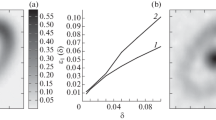Abstract
We consider a pair consisting of an optimization problem and its optimality function (P,θ), and define consistency of approximating problem-optimality function pairs, (P N ,θ N ) to (P,θ), in terms of the epigraphical convergence of the P N to P, and the hypographical convergence of the optimality functionsθ N toΛ. We then show that standard discretization techniques decompose semi-infinite optimization and optimal control problems into families of finite dimensional problems, which, together with associated optimality functions, are consistent discretizations to the original problems. We then present two types of techniques for using consistent approximations in obtaining an approximate solution of the original problems. The first is a “filter” type technique, similar to that used in conjunction with penalty functions, the second one is an adaptive discretization technique that can be viewed as an implementation of a conceptual algorithm for solving the original problems.
Similar content being viewed by others
References
B.M. Alekseev, V.M. Tikhomirov and S.V. Fomin,Optimalnoye Upravleniye (Optimal Control) (Nauka, Moscow, 1979).
L. Armijo, “Minimization of functions having continuous partial derivatives,”Pacific Journal of Mathematics, 16 (1966) 1–3.
H. Attouch,Variational Convergence for Functions and Operators (Pitman, London, 1984).
T.E. Baker and E. Polak, “On the optimal control of systems described by evolution equations,” to appear in:SIAM Journal on Control and Optimization.
R.H. Byrd and J. Nocedal, “A tool for the analysis of quasi-Newton methods with applications to unconstrained optimization,”SIAM Journal on Numerical Analysis 26(3) (1989) 729–739.
F.H. Clarke,Optimization and Nonsmooth Analysis (Wiley-Interscience, New York, 1983).
J.W. Daniel,The Approximation Minimization of Functionals (Prentice-Hall, Englewood Clifs, NJ, 1971).
S. Dolecki, G. Salinetti and R.J.-B. Wets, “Convergence of functions: Equisemicontinuity,”Transactions of the American Mathematical Society 276(1) (1983) 409–429.
J.C. Dunn, “Diagonally modified conditional gradient methods for input constrained optimal control problems,”SIAM Journal on Control and Optimization and Optimization 24 (1986) 1177–1191.
A. Fiacco and G. McCormack,Nonlinear Programming: Sequential Unconstrained Minimization Techniques (Wiley, New York, 1968).
R. Fletcher and C.M. Reeves, “Function minimization by conjugate gradients,”Computer Journal 7(2) (1964) 149–154.
A. Goldstein,Constructive Real Analysis (Harper, New York, 1967).
L. He and E. Polak, “An optimal diagonalization strategy for the solution of a class of optimal design problems,”IEEE Transactions on Automatic Control 35(3) (1990) 258–267.
R. Klessig and E. Polak, “An adaptive precision gradient method for optimal control,”SIAM Journal on Control and Optimization 11(1) (1973) 80–93.
C.T. Kelley and J.L. Northrup, “A pointwise quasi-Newton method for integral equations,”SIAM Journal on Numerical Analysis 25(5) (1988) 1138–1155.
S. Lang,Real Analysis (Addison-Wesley, Reading, MA, 1983, 2nd ed.).
O.L. Mangasarian and S. Fromowitz, “The Fritz John necessary optimality conditions in the presence of equality constraints,”Journal on Mathematical Analysis and Applications 17 (1967) 34–47.
E. Polak,Computational Methods in Optimization: A Unified Approach (Academic Press, New York, 1971).
E. Polak, “On the mathematical foundations of nondifferentiable optimization in engineering design,”SIAM Review 29(1) (1987) 21–91.
E. Polak, “Basics of minimax algorithms,” in: F.H. Clarke, V.F. Dem'yanov and F. Giannessi, eds.,Nonsmooth Optimization and Related Topics (Plenum Press, New York, 1989) pp. 343–367.
E. Polak and L. He, “A unified Phase I—Phase II method of feasible directions for semi-infinite optimization,”Journal of Optimization Theory and Applications 69(1) (1991) 83–107.
E. Polak and L. He, “Rate preserving discretization strategies for semi-infinite programming and optimal control,”SIAM Journal on Control and Optimization 30(3) (1992) 548–572.
E. Polak, D.Q. Mayne and J. Higgins, “On the extension of Newton's method to semi-infinite minimax problems,”SIAM Journal on Control and Optimization 30(2) (1992) 376–389.
L.S. Pontryagin, V.G. Boltyanskii, R.V. Gamkrelidze and E.F. Mischenko,The Mathematical Theory of Optimal Processes (Wiley-Interscience, New York, 1962).
B.N. Pshenichnyi and Yu.M. Danilin,Numerical Methods in Extremal Problems (Chislennye Metody v Ekstremal'nykh Zadachakh) (Nauka, Moscow, 1975).
R.T. Rockafellar and R.J.-B. Wets, “Variational systems, an introduction,” in: G. Salinetti, ed.,Multifunctions and Integrands Lecture Notes in Mathematics No. 1091 (Springer, Berlin, 1983, 1984).
E. Sachs, “Rates of convergence for adaptive Newton methods,”Journal of Optimization Theory and Applications 48(1) (1986) 175–190.
Author information
Authors and Affiliations
Additional information
This paper is dedicated to Phil Wolfe on the occasion of his 65th birthday.
The research reported here was sponsored by the Air Force Office of Scientific Research contract AFOSR-900068, the National Science Foundation grant ECS-8916168.
Rights and permissions
About this article
Cite this article
Polak, E. On the use of consistent approximations in the solution of semi-infinite optimization and optimal control problems. Mathematical Programming 62, 385–414 (1993). https://doi.org/10.1007/BF01585175
Received:
Revised:
Issue Date:
DOI: https://doi.org/10.1007/BF01585175




